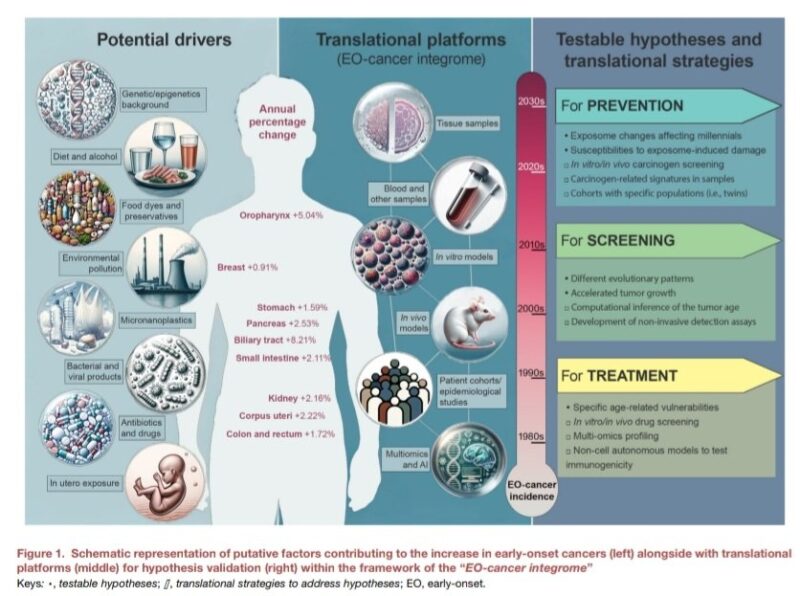María Natalia Gandur Quiroga shared on X:
“Early-Onset Cancers: Unraveling Biological Causes and Clinical Implications
Understanding Early-Onset Cancers Over the past three decades, the incidence of early-onset (EO) cancers—those diagnosed in individuals under the age of 50—has been rapidly rising. While EO cancers traditionally affected older adults, recent epidemiological data highlight a disturbing increase in diagnoses among adolescents and young adults, notably in cancers like colorectal cancer (CRC) and breast cancer (BC).
Key Points
- Rising Incidence:
➤ The incidence of EO cancers globally increased by 80% from 1990 to 2019, especially in gastrointestinal, colorectal, and breast cancers.
➤ Notably, EO-CRC is projected to account for one-third of all CRC cases by 2030.
- Impact of the Exposome:
➤ The rise in EO cancers may be linked to changes in environmental exposures, including diet Westernization, increased consumption of processed foods, exposure to carcinogens, and shifts in lifestyle factors like physical inactivity and obesity.
➤ Environmental pollutants, such as PM2.5 and microplastics, are also suspected contributors.
- Challenges in Screening:
➤ Current screening protocols may not be well-suited to EO cancers, especially in CRC, where tumors may develop faster in younger populations.
➤ Innovations like circulating tumor DNA (ctDNA) monitoring could be key in developing more effective, non-invasive screening strategies for early detection.
Hypotheses on EO Cancer Evolution
- Biological Peculiarities:
➤ EO cancers may follow different biological pathways compared to late-onset cancers. There is growing interest in understanding if EO tumors exhibit distinct molecular profiles that affect treatment responses, potentially requiring tailored therapeutic approaches.
- Multi-Omics Integration:
➤ Comprehensive multi-omics profiling is essential to uncover the genetic, epigenetic, and transcriptomic features unique to EO cancers. International collaborations and biobanks focusing on EO cancer samples are critical to advancing this research.
Conclusion
The surge in early-onset cancers presents an urgent public health challenge. By integrating epidemiological, environmental, and molecular data, we can develop a deeper understanding of the biology driving these cancers. This approach, referred to as the EO-cancer integrome, could ultimately lead to more effective prevention, diagnosis, and treatment strategies.”

Early-onset cancers: Biological bases and clinical implications
Authors: Gianluca Mauri, Giorgio Patelli, Andrea Sartore-Bianchi, Sergio Abrignani, Beatrice Bodega, Silvia Marsoni, Vincenzo Costanzo, Angela Bachi, Salvatore Siena, Alberto Bardelli

More posts featuring María Natalia Gandur Quiroga on oncodaily.com
María Natalia Gandur Quiroga is a Medical Oncologist and Chief of the Division of Genitourinary Medical Oncology at the Ángel H. Roffo Oncology Institute in Buenos Aires, Argentina. She is a Professor of Medicine at the University of Buenos Aires at the Oncologists Post Graduates Studies. Her research focuses on clinical trials with aims to improve the treatment of patients with urologic tumors. She is an active member of the European Association for Cancer Research, Argentinian Medical Association and American Society of Clinical Oncology.
